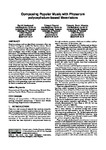Composing Popular Music with Physarum polycephalum-based Memristors
| dc.contributor.author | Venkatesh, S | |
| dc.contributor.author | Braund, Edward | |
| dc.contributor.author | Miranda, Eduardo | |
| dc.date.accessioned | 2020-10-16T09:07:35Z | |
| dc.date.issued | 2020-07-21 | |
| dc.identifier.issn | 2220-4806 | |
| dc.identifier.issn | 2220-4806 | |
| dc.identifier.uri | http://hdl.handle.net/10026.1/16543 | |
| dc.description.abstract |
Creative systems such as algorithmic composers often use Artificial Intelligence models like Markov chains, Artificial Neural Networks, and Genetic Algorithms in order to model stochastic processes. Unconventional Computing (UC) technologies explore non-digital ways of data storage, processing, input, and output. UC paradigms such as Quantum Computing and Biocomputing delve into domains beyond the binary bit to handle complex non-linear functions. In this paper, we harness Physarum polycephalum as memristors to process and generate creative data for popular music. While there has been research conducted in this area, the literature lacks examples of popular music and how the organism’s non-linear behaviour can be controlled while composing music. This is important because non-linear forms of representation are not as obvious as conventional digital means. This study aims at disseminating this technology to non-experts and musicians so that they can incorporate it in their creative processes. Furthermore, it combines resistors and memristors to have more flexibility while generating music and optimises parameters for faster processing and performance. | |
| dc.format.extent | 514-519 | |
| dc.language.iso | en | |
| dc.publisher | Birmingham City University | |
| dc.subject | Unconventional Computing | |
| dc.subject | Biocomputing | |
| dc.subject | Musical Composition | |
| dc.subject | Popular Music | |
| dc.subject | Physarum polycephalum | |
| dc.title | Composing Popular Music with Physarum polycephalum-based Memristors | |
| dc.type | conference | |
| dc.type | Conference Proceeding | |
| plymouth.date-start | 2020-07-21 | |
| plymouth.date-finish | 2020-07-25 | |
| plymouth.publisher-url | http://www.nime.org/archives/ | |
| plymouth.conference-name | International Conference on New Interfaces for Musical Expression (NIME) | |
| plymouth.publication-status | Published | |
| plymouth.journal | Proceedings of the International Conference on New Interfaces for Musical Expression (NIME) | |
| plymouth.organisational-group | /Plymouth | |
| plymouth.organisational-group | /Plymouth/Faculty of Arts, Humanities and Business | |
| plymouth.organisational-group | /Plymouth/REF 2021 Researchers by UoA | |
| plymouth.organisational-group | /Plymouth/REF 2021 Researchers by UoA/UoA33 Music, Drama, Dance, Performing Arts, Film and Screen Studies | |
| plymouth.organisational-group | /Plymouth/Users by role | |
| plymouth.organisational-group | /Plymouth/Users by role/Academics | |
| plymouth.organisational-group | /Plymouth/Users by role/Researchers in ResearchFish submission | |
| dcterms.dateAccepted | 2020-07-18 | |
| dc.rights.embargodate | 2020-10-17 | |
| dc.identifier.eissn | 2220-4806 | |
| dc.rights.embargoperiod | Not known | |
| rioxxterms.version | Version of Record | |
| rioxxterms.licenseref.uri | http://www.rioxx.net/licenses/all-rights-reserved | |
| rioxxterms.licenseref.startdate | 2020-07-21 | |
| rioxxterms.type | Conference Paper/Proceeding/Abstract |


